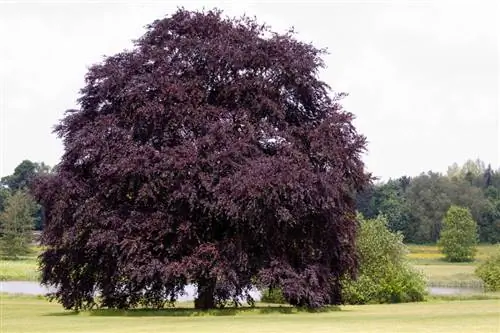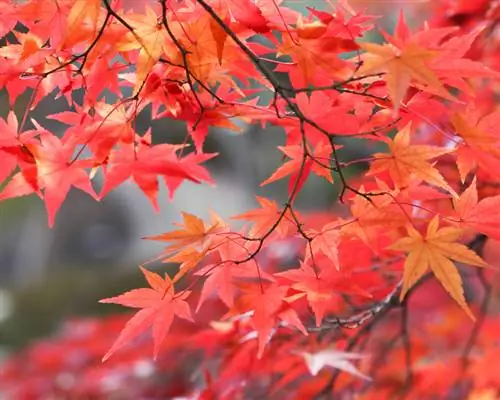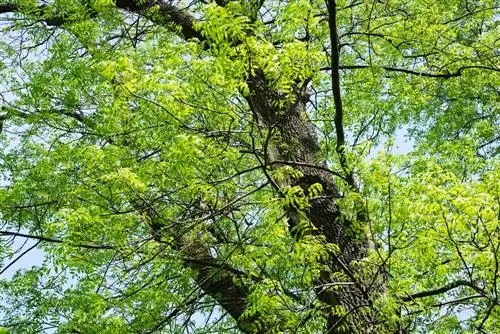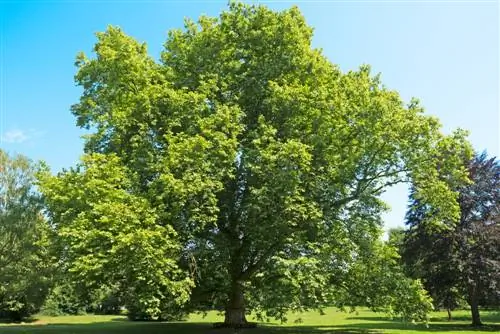- Author admin [email protected].
- Public 2023-12-16 16:46.
- Last modified 2025-06-01 06:02.
Without the diverse maple species, the world would be a barren place. From Europe to America, from Asia to Australia, the maple genus enriches forests, avenues, parks and gardens. Reason enough to take a closer look at the fascinating cosmopolitan. This profile provides a colorful array of interesting details about the maple tree.
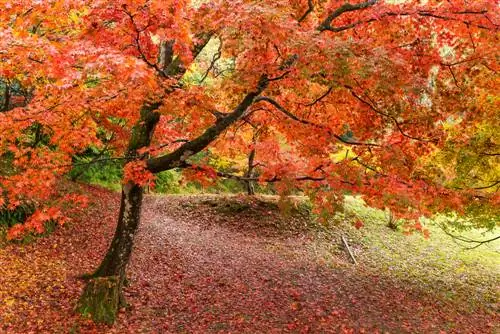
What are the most important properties of maple trees?
Maple profile: Maples (Acer) belong to the horse chestnut family and come in 150 to 200 species. They are deciduous trees or shrubs with growth heights of 80 cm to 30 m. The leaf shape is palmate, lobed or pinnate, and the flowering period is in spring (March - May) with inconspicuous yellow-green flowers.
Botanical systematics and appearance
For the interested home gardener, important information about the suitability of the maple tree for the garden lies behind sober key data such as height of growth or winter hardiness. Of course, decorative aspects of the appearance should not be missing, such as leaf shape or flowering time, as well as important criteria for the family garden, such as possible toxins. The following profile provides all the fundamental characteristics of the genus at a glance:
- Name of the genus: Maples (Acer) with 150 to 200 species
- Hippocastanoideae family
- Areas of distribution: Europe, North and Central America, Asia, North Africa to the tropics
- Deciduous trees or shrubs
- Growth heights from 80 cm to 30 m, rarely up to 40 m
- Leaf shape: palmate, multilobed, rarely pinnately pinnate
- Leaf color: medium green, lighter underneath, yellow-orange to bright red in autumn
- Flowering time in Europe: March/April to April/May with inconspicuous, yellow-green flowers
- Winged split fruits in autumn
- Poison content: Sycamore maple seeds and shoots fatally poisonous to horses and donkeys
- Age: 200 to 500 years
In Europe, three native maple species and their cultivars dominate the picture. Sycamore maple (Acer pseudoplatanus), Norway maple (Acer platanoides) and field maple (Acer campestre) have held their own in the local climate since the last ice age and have reliable frost hardiness. Slotted maple (Acer palmatum) that migrated from Asia is still hardy enough to showcase its compact growth and magnificent varieties in European gardens.
Ingenious propagation strategy - fruits with a fun factor
The maple tree uses a sophisticated propagation strategy that also increases its popularity among children. So that the fruits cover as large a radius as possible, they are equipped with two wings. These protrude from the nuts at an acute or obtuse angle. On the one hand, this aerodynamic shape causes long-range transport with the wind and, on the other hand, a remarkable autorotation during descent, which is reminiscent of small helicopters.
Before the ripe fruits and their wings fall apart into two halves, they serve as funny nose pinchers for children. Even a single maple tree is enough to rejuvenate a 10,000 m² area with offspring. Resourceful home gardeners harvest the seeds to use them for targeted propagation.
A piece of jewelry for the garden and balcony - tips on possible uses
The maple genus gives us a varied melange of magnificent species and varieties for creative garden design. We have compiled an excerpt of imaginative possible uses for you below:
- Majestic eye-catcher for the extensive park and large garden: sycamore maple and Norway maple
- Elegant house tree for the front garden: globe maple Globosum or globe maple Nanum
- Decorative privacy and wind protection hedge: field maple (Maßholder) or ornamental field maple Red Shine
- Attractive potted plant: Asian slot maple with furious varieties, such as the dark red 'Dissectum Garnet'
Almost all members of the genus are suitable for cultivation as bonsai. Sycamore maple has the potential to become an impressive outdoor bonsai for beds and balconies. Field maple is easy to cut and forgives beginners in the art of bonsai many a beginner's mistake. Thanks to its fine branching, filigree leaves and bright leaf colors, Japanese Japanese maple is ideal for indoor and outdoor bonsai.
Ecologically valuable - maple is more than just a pretty backdrop
Limiting the maple tree to its decorative function does not do justice to its importance for nature. The interesting genus makes a valuable contribution to ecological balance in many ways:
- The yellow-green to reddish flowers serve as a popular pasture for bees and butterflies
- Roots close to the surface loosen the soil thoroughly
- Autumn leaves quickly decompose into rich humus
Shrub-like maple species, such as field maple, gather to form dense hedges that bear their leaves for a long time. Birds, insects and small animals know how to use this to breed here or to seek protection from predators and winter cold.
Maple syrup - sweet temptation
In North America and Canada, maple syrup is an integral part of the cuisine. In Europe, the sugary-sweet, sticky juice is becoming increasingly popular with young and old alike to enjoy with small pancakes, muffins, ice cream or in drinks. The sweet temptation is made from the Canadian maple, also known as sugar maple. For this purpose, the trunk is drilled and the sap flowing out is collected.
The main supplier of maple syrup is Canada with more than 80 percent of world production. Maple trees are so important to this country that a red maple leaf adorns the national flag.
Tip
One of the most striking maple trees in Germany can be viewed in Hamburg. The sycamore maple in the deer park is 200 to 220 years old and around 25 meters high. With a crown width of a whopping 36 meters, the giant more than doubles the average volume. The mighty trunk is richly branched and measured an impressive 6.39 meters in circumference when last measured in 2012.



